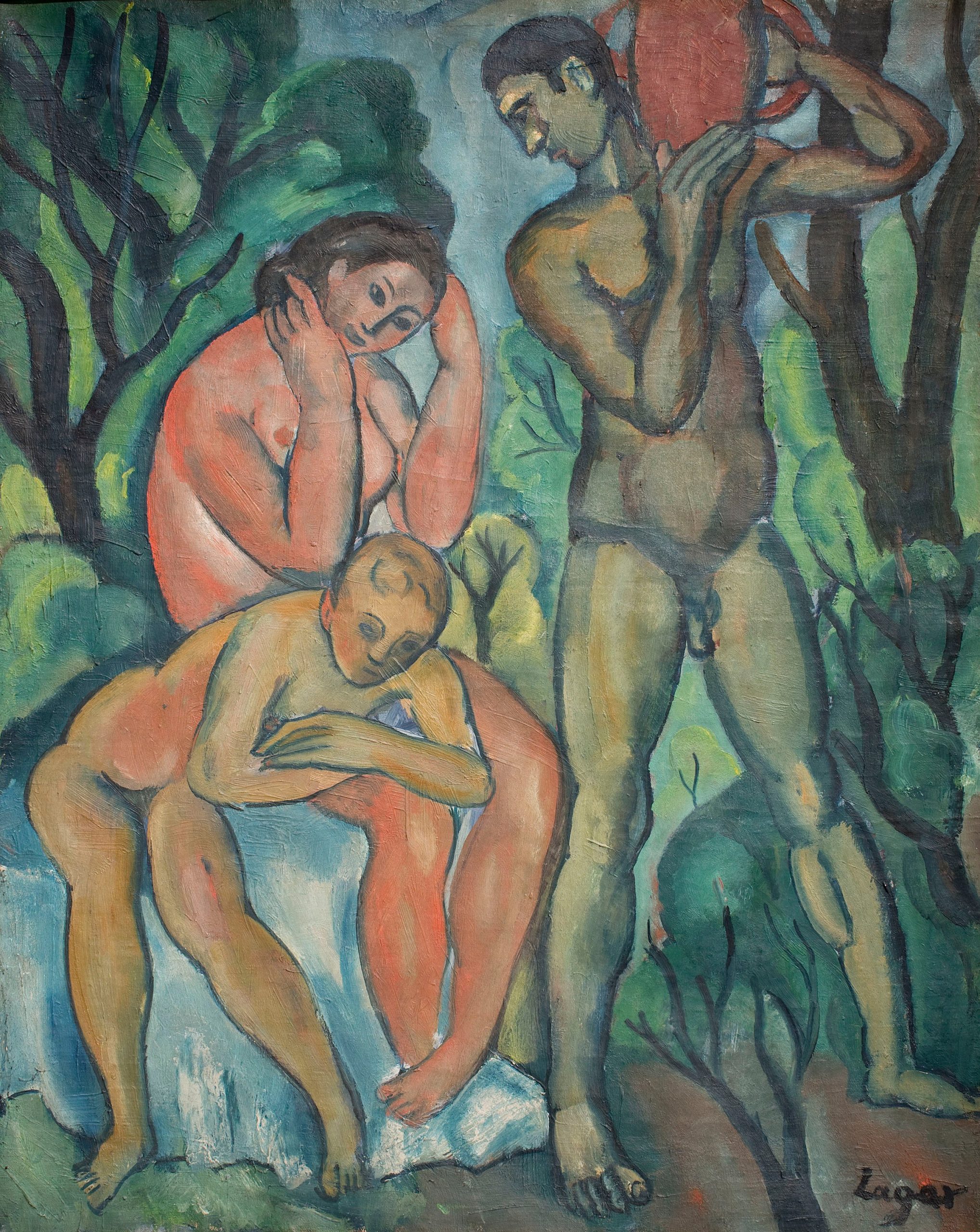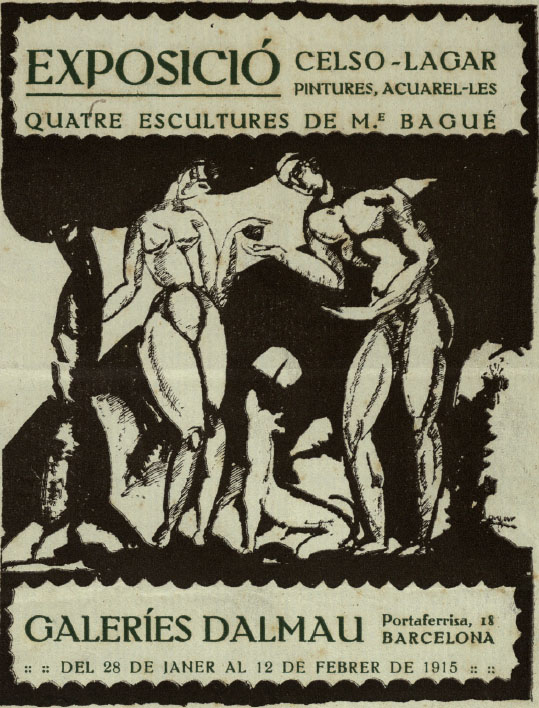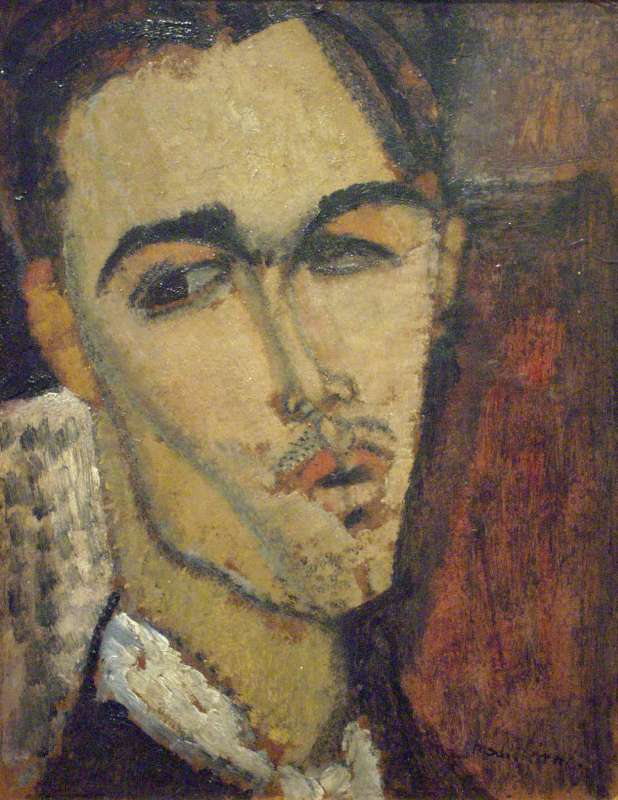M. Lluïsa Faxedas
The exhibition Celso Lagar and Hortense Bégué. The Catalan Years (1915-1918), which can currently be visited at the Museu d’Art de Girona, includes some pieces and documents from the collections of the MNAC.
Among them are the small catalogues of the exhibitions that Lagar mounted in 1916 and 1918 at Galeries Laietanes, the latter together with his partner Hortense, which are essential for learning about what he exhibited and, therefore, what he was painting during this period in Catalonia. There is also a postcard that Lagar sent to his gallerist and dealer Santiago Segura, the promotor of the Laietanes, to wish him a Happy New Year for 1918, and which he illustrated with the watercolour of a still life very much along the lines of what he was working on at the time. And finally, we also find the oil painting Pastoral, one of the most outstanding of all the pieces he painted during his stay in Catalonia.
Celso Lagar (Barcelona, Galeries Laietanes, 23/9/1916-14/10/1916) / Celso Lagar. Escultures i dibuixos animalistes de Hortanse Begué. (Barcelona, Galeries Laietanes, 1/4/1918-14/10/1918). Biblioteca Joaquim Folch i Torres
Postcard that Lagar sent to his gallerist and dealer Santiago Segura, the promotor of the Laietanes, to wish him a Happy New Year for 1918. Museu Nacional d’Art de Catalunya
About this painting, however, we know very little, as this title does not enable us to identify it definitely with any of the works included in the catalogues that we know of Lagar’s exhibitions between 1915 and 1918. The piece entered the museum’s collection in 1960 as a donation by Sr. J. S. Dellal with the Crane Kalman Gallery in London as the middleman. This means that Lagar must almost certainly have taken the painting with him to Paris when he returned there in 1919; that is where the English gallerist Crane Kalman would contact him in the late 1950s, and would make a great effort to publicize his work, almost forgotten by then.

Celso Lagar. Pastoral. 1916.Oil on canvas. 80,5 x 65 cm
From the thematic and formal point of view the painting is very close to the works considered to be the most “noucentista” of all those Lagar painted, as long as we regard primitivism as a characteristic closely related to the movement, and we can therefore date it to between 1915 and 1916. It can be compared, for example, with the print that appears on the cover of the catalogue of the exhibition at the Galeries Dalmau in 1915, in which a figure evocative of Eve offers a piece of fruit to Adam under the watchful gaze of a dog. On the print, the pronounced features of the figures are openly primitivist, and in particular the woman’s face-mask, with its almond-shaped eyes, points to an element highly characteristic of Lagar’s work; in the painting, the features are slightly toned down.

Celso Lagar i M.Bagué. Catàleg de l’Exposició de Celso-Lagar i Hortense Begué, organitzada a les Galeries Dalmau del carrer Portaferrisa, del 28 de gener al 12 de febrer. 1915. Barcelona. Arxiu municipal de Girona
Another work with which it displays interesting similarities is Life in the Country (1915), which could be seen in the first exhibition that Lagar held in Catalonia, at Galeries Dalmau in February 1915. In this painting two nude women smile at us from a vaguely Mediterranean rural landscape; in the MNAC’s oil painting there appears what we might identify as a family, also naked against a natural background. Both works refer to the motifs of youth, motherhood, fertility, childlike innocence and harmony with nature, closely associated with the pastoral iconography that was so successful in European painting in the early years of the century. In this context, the subject of the pastoral evoked a certain degree of nostalgia for a natural life lost due to the rapid changes imposed by industrialization and the hustle and bustle of city living; although it is a subject with classical resonances, many modern artists, such as Signac, Gauguin and Matisse, used it. In the context of Catalan art, it was also the subject chosen by Joaquim Sunyer in two of his most iconic works, Pastoral and Mediterrània, both from 1910-11.
Indeed, in Lagar’s work in the Catalan period, and more specifically in that which we identify with this more primitivist trend, we can detect clear concomitances with Sunyer’s painting, above all in how the trees are painted, in a certain geometricization of the landscape, and in this subject in which nude bodies are integrated in the landscapes. One can clearly see the influence of Cézanne’s painting, highly appreciated at that time in Catalonia, in the work of both of them. In 1915 Lagar published an article in the Girona journal Cultura entitled “El Renacimiento del arte después del cubismo” (The Rebirth of Art After Cubism), in which he mentioned the French artist’s role as a precursor in the genesis of modern painting, and he ended up presenting himself as the initiator of a primitive art, paraphrasing Cézanne who saw himself as “a primitive of a new art”.
Celso Lagar «El renacimiento del arte después del cubismo», Cultura, any II, vol. I, núm. VI, febrer 1915, p. 181-182
In the case of Lagar, and specifically in this Pastoral, as I mentioned earlier, we also see a heavy accentuation of the primitivist features of the faces and bodies of his figures (almond-shaped eyes, oval-shaped faces-masks, rounded and simplified body shapes), which he shares with the work of his partner, the sculptress Hortense Bégué (as shown by the excellent Cap de dona [Head of a Woman, 1913] present in the exhibition in Girona). Both of them must have become interested in this primitivist element in Paris in the years before they came to Catalonia, because it was then one of the most important trends of the time. The mutual friendship with Modigliani, who painted a magnificent Portrait of the Painter Celso Lagar, would have strengthened this interest in the primitive as a source of modernity; and they in turn could have influenced some Catalan artists, as in the case of the young sculptor from Girona Fidel Aguilar, with whose work we see obvious points in common.

Amedeo Modigliani. Portrait of the painter Celso Lagar. 1915. Oli sobre cartró. 35 x 27 cm. © The Israel Museum, Jerusalem
Universitat de Girona
















